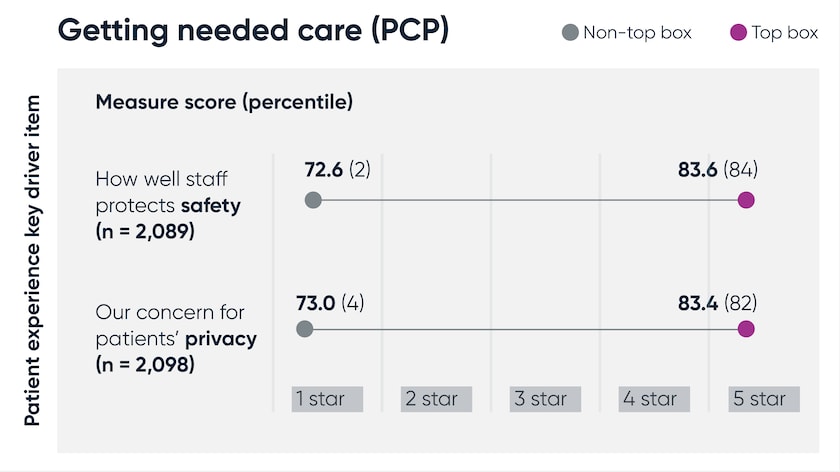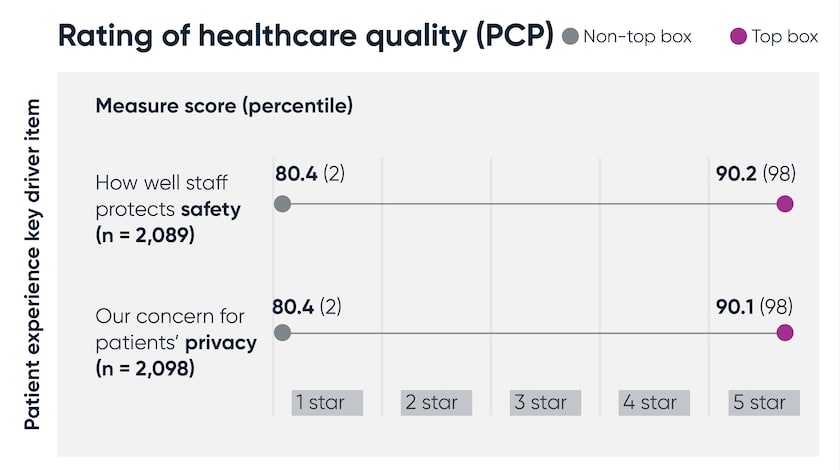Safety: The unsung hero of member experience
Health plans are always navigating an evolving landscape, where member expectations are at an all-time high. They want seamless access, clear communication, and an optimal experience in every healthcare interaction. And, as competition grows, regulatory pressures intensify, and trust becomes a key differentiator, the pressure to deliver an exceptional experience has never been greater.
Traditionally, health plans have focused on improving the member experience through customer service, benefit design, member communication, and responsiveness, while closely monitoring members’ perceptions of quality through surveys and other feedback channels. But new insights from Press Ganey’s database—spanning 5.5 billion patient encounters—as well as out partnerships with every 5-star plan and 77% of 4-star plans, highlight two often overlooked yet increasingly vital factors: patient safety and patient privacy.
Today, I want to focus on just one of those metrics: patient safety, and its connection to health plan member experience.
Members who rate safety poorly in post-care patient experience surveys consistently score their health plans lower in Medicare CAHPS surveys—particularly on measures like “rating of healthcare quality” and “getting needed care.” This underscores the importance of perceived safety, which can be shaped by factors like communication, facility cleanliness, follow-up care, and teamwork among healthcare providers. Perceived safety has a direct impact on patient experience. When it’s lacking, ratings decline. But when they feel safe and secure in their care, their experience improves, strengthening Star Ratings and overall plan performance.
Health plans that prioritize patient safety see a 12% increase in care quality ratings, rising from 1 to 5 stars.
Safety: The strategic lever for to drive member loyalty, trust, and Star Ratings
Safety is no longer strictly a quality issue. It’s a business imperative for health plans. Those that actively address safety concerns can improve member retention and strengthen long-term relationships with their members, while also optimizing quality.
When members perceive their care as safe, health plans see a 12% increase in quality ratings. Patients who rate safety poorly in post-care primary care provider (PCP) surveys, on average, give health plans 1 star for “rating of healthcare quality” and “getting needed care” in Medicare CAHPS surveys, while those who rate it highly give 5 stars. Organizations that prioritize safety and high reliability see reduced harm, improved patient experiences, and a 10x ROI in financial performance.


By treating safety as a core element of the patient and member experience, health plans:
- Identify and mitigate safety risks before they escalate
- Build trust and confidence among members
- Reduce member disenrollment and strengthen long-term relationships
- Improve Star Ratings and overall plan performance
Improving safety is about reducing adverse events and preventable harm. And it’s about understanding patient perceptions of safety. That is, patients need to be safe—but they also need to feel safe. Even with strong safety metrics, if patients perceive risk or discomfort, their experience may decline, impacting experience scores and health plan ratings. Driving meaningful improvements requires a proactive strategy to address both.
Connecting the dots between safety and experience
When health plans identify safety risks—such as diagnostic delays or treatment gaps—they can take proactive steps to improve outcomes. Analyzing member complaints and experience data trends enables targeted interventions for specific issues, like optimizing medication reconciliation. It also reinforces the need for integrating high reliability practices like leader rounding and team training.
By improving data-sharing, collaboration, and performance incentives, health plans can go beyond traditional member experience efforts and make safety a core driver of satisfaction and experience. This approach strengthens outcomes, trust, and loyalty.
To further explore the connection between safety and the member experience, download Press Ganey’s latest member experience report, or reach out to our team.